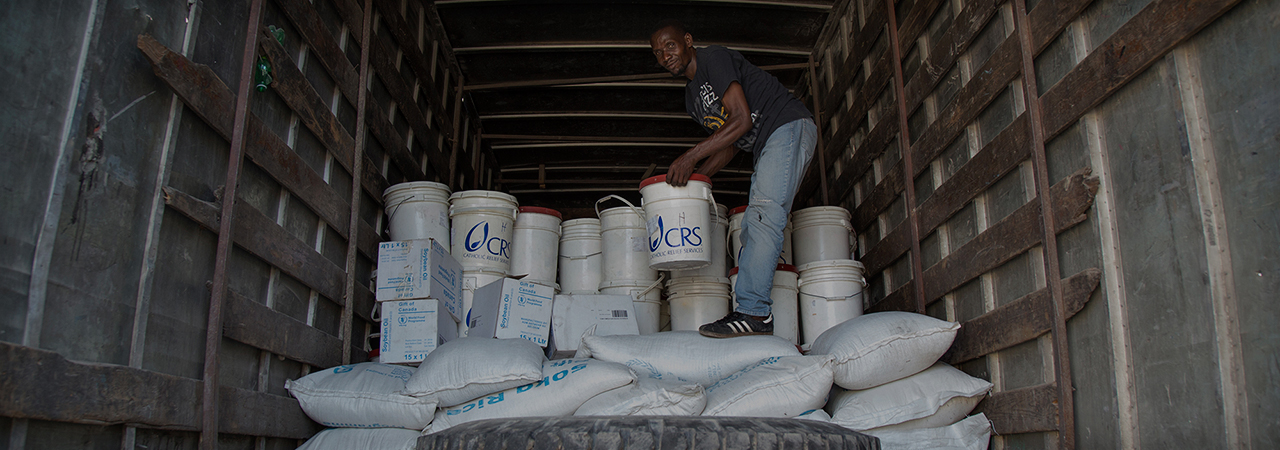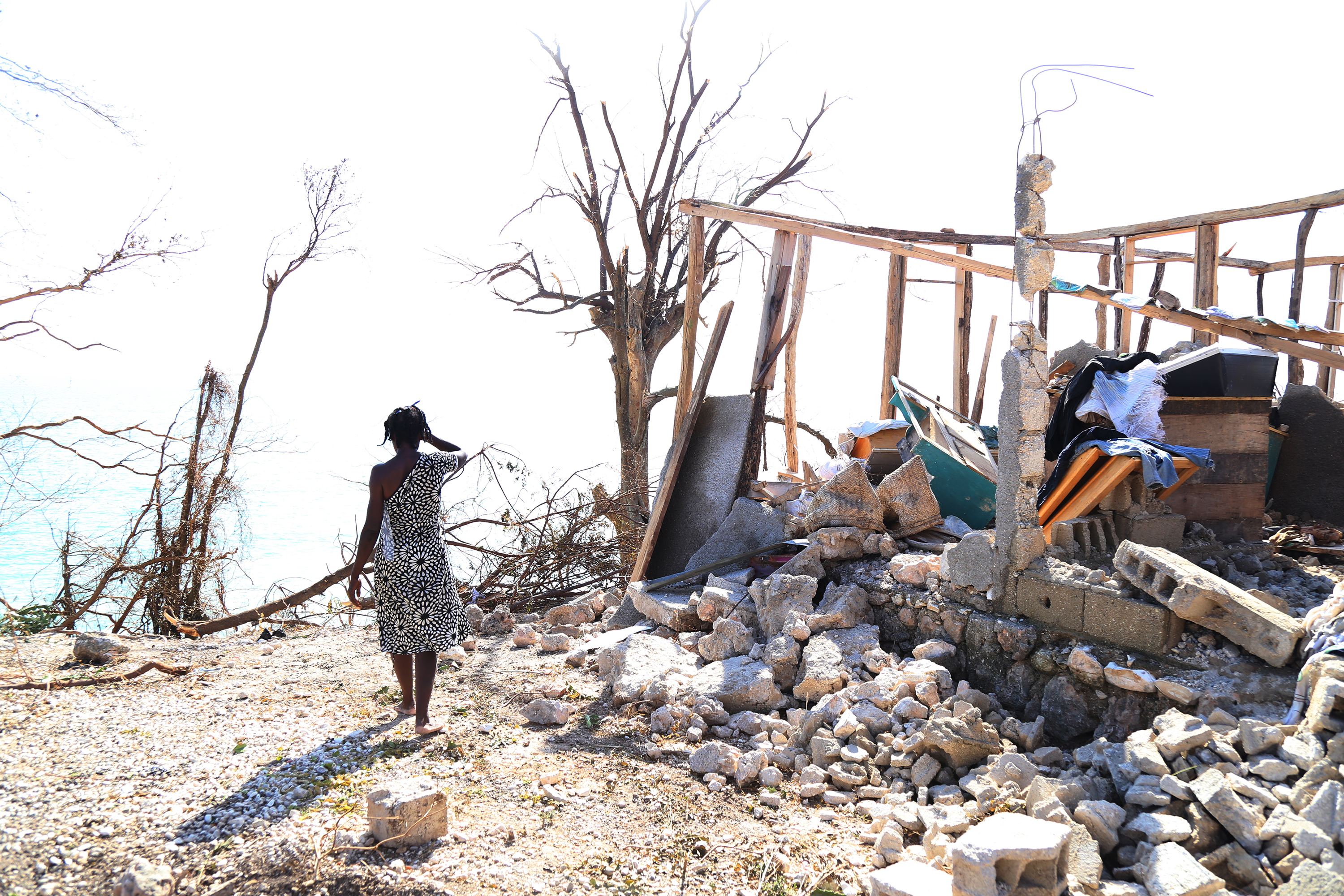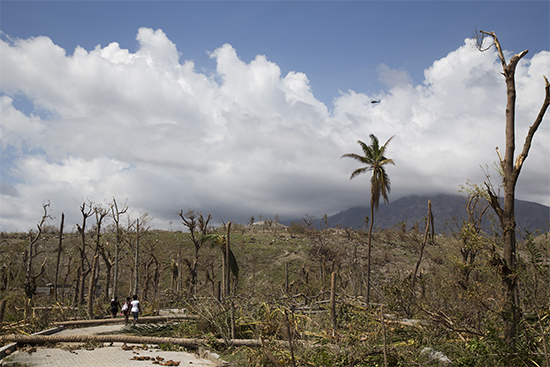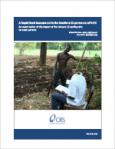

Media CenterCRS Responding to Hurricane Matthew in the Caribbean
Updated October 9, 2016
11:30am
With as many as 900 killed and tens of thousands of homes destroyed in Haiti, the devastation caused by Hurricane Matthew is becoming more clear as officials and aid workers are starting to reach remote areas.
CRS teams have made it some of these areas, including Roche a Bateau, a small beach town on Haiti’s southwestern coast, where they’re distributing critically needed bottled water and food to 250 families.
Roche a Bateau is one of the hardest hit areas. In the town of 3,000, only 17 houses remain.

“Everyone we talked to lost their house,” said CRS’ Robyn Fieser, who traveled with an emergency team to the area on Oct. 9, five days after Hurricane Matthew pummeled this peninsula with 145 mph winds and torrential rain. “People are stunned and dazed, and someone told me ‘I don’t even recognize where I am.’
“It’s just devastated,” she said. “You can’t even believe that a hurricane could do that. People’s houses are gone; fields are gone; any food sources are gone. And now they have nothing eat. It’s really bad.”
Food provided by CRS includes staples such as rice, beans and oil.

‘Sheer Devastation’
In Roche Bateau, fruit trees including avocado and banana are an important source of food but the storm has decimated all vegetation.
“People lost all the trees, every tree is down, it’s like a mangled mess of dead trees,” Fieser said. “And there are dead animals floating in small bodies of water.”
Bernadette Moses, a resident of the town, was in her house with her child when Hurricane Matthew made landfall. She waited until 2 am but grew increasingly terrified the house could collapse around them. She took her child and ran to a nearby field, where she waited out the storm and somehow survived. Her home did not.
Looking at the devastation all around her, she said, “This is worse than anything we have ever seen. The rain is not a problem for us -- we have been through storms before --
It's the wind that killed us.”
With almost the entire town leveled, “people are staying with friends or relatives, if they’re lucky,” Fieser said. “But it’s getting to a point where any fruit that could’ve been salvaged from the trees is now gone and food is going to be a very big issue in next days.”
Threat of Cholera
Food scarcity is only one of the challenges on Tiburon, Haiti’s mountainous southern peninsula that is a major bread basket for the country. Fields and crops have been destroyed. A lack of clean water and sanitation now poses a great risk for cholera. In Port a Piment, just a few miles up the coast from Roche a Bateau, there have already been reports of 60 cases. The area suffered an outbreak of the deadly disease after the 2010 earthquake and “now it’s starting to flare up,” a nurse told Fieser.
To combat its spread, CRS is distributing hygiene kits, including soap, buckets and toothbrushes, as well as kitchen utensils and blankets.
CRS, which has worked in Haiti since it was devastated by Hurricane Hazel in 1954, has made an initial commitment of $5 million to help in Haiti and other countries affected by Matthew.
For more information on how CRS responded the Haiti’s massive earthquake in 2010, click here.
-------------------------------------------------------------------
Updated October 6, 2016
3:00pm
As Haiti’s official death toll from Hurricane Matthew moved past 100, Catholic Relief Services (CRS) staff in the hard-hit southwest region of that country are getting to work to help the thousands affected by the storm.
The CRS personnel who rode out the storm in Les Cayes are assembling kits containing hygiene, kitchen and shelter supplies for distribution in this hard-hit city. They report that many houses are without roofs and those near the sea totally destroyed.
Water from Matthew’s heavy rainfall and wind-driven storm surge was over three feet deep in many parts of the town, flooding into homes. People are beginning to return to markets in search of food and trying to dry clothing and other household items even as the rainfall continues.
In the Dominican Republic and other nearby countries, CRS staff members are obtaining supplies – including tarpaulins for temporary shelter – that will be brought to Haiti’s southwest region as soon as transportation resumes. Flights are expected to start up soon while overland traffic awaits reconstruction of a bridge that was washed out by flooding.
For more information on how CRS responded the Haiti’s massive earthquake in 2010, click here.
-------------------------------------------------------------------
Updated October 5, 2016
5:00pm
Three CRS staff rode out Hurricane Matthew in the small coastal town of Dame Marie that was directly in the path of the center of the storm. Though suffering no injuries themselves, they reported almost all of the buildings in this town of 15,000 were destroyed.
The 30,000 residents of Jeremie, on the northern side of the peninsula that is southwest Haiti, were said to be without water and also facing widespread destruction and no communications.
The latest reports from Les Cayes, where CRS’ main office in the region is located, are of no electricity and damage to even substantial buildings, including the Church, schools and the roof of the hospital.
CRS staff said they hope to expand relief efforts when flights to the region resume. Work continues on a bridge damaged in the storm, cutting the highway linking the area to the capital Port-au-Prince. Its repair will allow automobiles and trucks to reach the area.
-------------------------------------------------------------------
Updated October 5, 2016
1:00pm
The first reports on Hurricane Matthew’s landfall in Haiti from the CRS office in Les Cayes indicate severe damage from wind and water. There’s also a fear of widespread crop loss and food stocks, not just in Les Cayes – and important bread basket for Haiti - but also in the mountains around Port-au-Prince, where the storm caused heavy winds.
Les Cayes is on the southwest coast of Haiti where Matthew made its first landfall with its strongest winds – over 140 mph – and drenching rain.
CRS has long had a presence in Les Cayes and our staff there rode out the storm and is now working to get the office operational – repairing damage to the roof and generator – as others are heading out into the city and surrounding areas to see specifically what area residents need.
If CRS’ stocks of relief supplies on hand – blankets, hygiene items, kitchen kits – survived the storm intact they will be distributed to the hardest hit areas.
CRS is also ready with cash distributions to help people get through these next few days and weeks as the area markets come back to life.
But reports of damage to crops and the loss of stored food mean that prices may spike in the short-term while the impact of this hurricane could affect the food supply of the region, and the entire country, for years to come.
CRS is also working with local partners to monitor the impact of Matthew on Cuba and the Dominican Republic and will respond when the situation on the ground becomes clear.
-------------------------------------------------------------------
Updated October 4, 2016
12:00 pm
CRS staff in Les Cayes, Haiti, are reporting flooding from heavy rains and trees knocked down by strong winds as Hurricane Matthew made landfall.
“One of the biggest problems is that the infrastructure is not able to handle so much rain in low-lying area around Les Cayes,” said Chris Bessey, CRS’ country representative based in Port-au-Prince. “We’ll have to wait and see how bad the damage is, but flooding is a big concern.”
Before the storm hit, CRS engineers were dispatched to field offices in Les Cayes, Jeremie and Jacmel – cities in the southwest part of Haiti that are directly in its path – and are on stand-by to assess structural damage and begin repairs. Based on the extent of damage, part of CRS’ response could include temporary shelters and distribution of shelter materials like tarps.
Bessey stressed the danger from falling trees and debris as roofs are ripped off buildings.
“The storm is likely to affect people’s access to supplies and services, and there’s a risk many will lose their food stocks,” he added.
In Port-au-Prince, the biggest danger is flooding from heavy rains and the storm surge in this city with its many hillsides and ravines and little drainage infrastructure.
This could set back continuing efforts to recover from the 2010 earthquake. Bessey noted one year-long project, building a road to a poor community that has had to use a narrow path through a ravine to reach nearby markets and businesses.
“There’s a high likelihood that there will be damage to our ongoing work, which will slow things down,” he said. “Our concern now is that we’ll lose progress and the community will have to wait even longer.”
-------------------------------------------------------------------
Updated October 3, 2016
1:00 pm
Jean Simon Ludger of CRS' office in Les Cayes, says that weather still seems calm as Hurricane Matthew takes dead aim on this city of 70,000 with winds reaching 130 mph and torrential rain that may end up being measured in feet, not inches.
CRS is working with the local government to inspect shelters – in some cases securing roofs – and move people into them.
But Ludger expressed his concern for the many who amid the calm weather do not understand the severity of this hurricane and are refusing to move.
“What scares me is that there are many fragile areas where flash flooding and landslides can be a great problem,” he said. “People are living in slums where houses are not well constructed and can easily be taken away by floods and landslides.”
Ludger is a specialist in agriculture but, like all CRS staff in Haiti, is now working to reduce the damage from this slow-moving hurricane that is expected to make landfall Monday night.
-------------------------------------------------------------------
Updated October 3, 2016
9:30 am
CRS teams are standing ready to respond to a potential disaster as Hurricane Matthew, a category 4 storm, is expected to hit near southwestern Haiti and Jamaica on Monday. According to forecasts, the areas of South and Grande Anse, on the southern peninsula of Haiti, will be hit hardest, and up to 25 inches of rain in some areas could result in deadly flash floods and mudslides.
“On Saturday night, a 10-minute downpour resulted in flooding in Les Cayes,” said Christopher Bessey, CRS country representative in Haiti. “Hurricane Matthew will bring much more, not to mention the storm surge.”
The Haitian government is urging vulnerable families living in inadequate housing made of cardboard or scrap wood with corrugated metal roofs to take refuge in schools and churches. CRS is providing gas to some schools in Les Cayes to operate as evacuation centers.
Dr. Fonie Pierre, who runs CRS’ office in Les Cayes, said many people who live near ravines, where there’s a high risk of mudslides, are already in government evacuation centers. She cautioned, however, that the centers often do not have adequate bathroom facilities and that food will quickly become an issue.
Coordinating closely with emergency operations centers and local partners, including Caritas, CRS emergency response teams are now on standby to quickly assess the needs and mount an immediate response in the affected countries.
In Haiti, CRS has a robust network of logistical and human resources, particularly in Les Cayes, and is ready to move personnel and transport and deliver relief items.
As soon as the storm passes, CRS is poised to:
- Repair and provide emergency shelters in the hardest-hit areas.
- Provide those affected in the capital cities of Jeremie and Les Cayes with cash so they can purchases critically needed relief supplies.
- Distribute pre-positioned relief items, including bottled water, water purification tabs, blankets, tarps and tents, and kitchen kits.
“Hurricane Matthew will be only the seventh major hurricane to hit Haiti directly, and [the city of] Les Cayes and the southern departments, and the brave people here are once again taking on this tremendous challenge,” Bessey said.
CRS has worked in Haiti since 1954, responding to Hurricane Hazel. In 2010, CRS responded to the massive 7.8 magnitude earthquake the struck in the country’s capital, Port-au-Prince, killing scores of people.
In Jamaica, our partner, the St. Patrick’s Rangers, is tracking the hurricane, and has been alerting vulnerable communities about its potential impact, and cutting trees and cleaning drains to decrease flooding. The St. Patrick Rangers, a voluntary youth club, works with national and local agencies to build the disaster management capacity of at-risk communities in Kingston.



